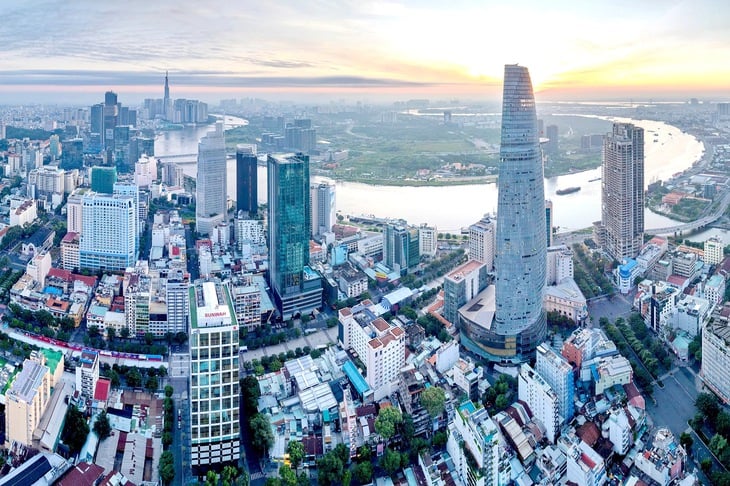
The central area of Ho Chi Minh City with many office buildings is considered to have many advantages to form an international financial center - Photo: VAN TRUNG
This morning, August 2, the Ministry of Finance and the Ho Chi Minh City People's Committee held a conference to announce the National Assembly's resolution on the international financial center in Vietnam. This is considered a strategic step, not only contributing to promoting the country's economy but also affirming Vietnam's new position on the global financial map.
A series of incentives for investors
The National Assembly's Resolution on the international financial center in Vietnam (Resolution No. 222) will take effect from September 1, an important legal step to build an international financial center located in Ho Chi Minh City and Da Nang .
A series of preferential policies have been designed to create an attractive and competitive business environment, attracting financial enterprises, investment funds, financial technology companies and strategic investors from all over the world to converge in Vietnam.
In particular, the income of enterprises from new investment projects in the international financial center in priority industries is subject to a corporate income tax rate of 10% for 30 years, corporate income tax exemption for no more than 4 years and a 50% reduction in payable tax for no more than the next 9 years. Even projects not in priority industries receive similar incentives but for a shorter period.
Regarding personal income tax, managers, experts, scientists, and highly qualified people working at the international financial center are exempt from personal income tax until the end of 2030. Meanwhile, individuals with income from transferring shares, capital contributions, and capital contribution rights to members of the center are also exempt from personal income tax until the end of 2030.
Regarding foreign exchange policy, members are allowed to use foreign currencies in operations, transactions and services. It is especially important that businesses can transfer capital in and out of the center more conveniently.
In addition, financial policies and capital market development are also preferential to attract capital for businesses in the financial center.
In particular, the resolution also stipulates controlled experimental financial policies for financial services applying technology (fintech) and innovation. Preferential policies for key areas such as green finance, digital assets and fintech, commodity and derivative markets, etc. are also decentralized so that the executive agency is allowed to issue them.
Opportunity to attract capital into green transformation, digital transformation
Speaking with Tuoi Tre, Mr. Pham Xuan Hoe - General Secretary of the Vietnam Financial Leasing Association - said that the establishment of an international financial center in Ho Chi Minh City will have four major impacts on the city's development.
The first is to attract a large amount of foreign investment through FII (foreign indirect investment) and FDI (foreign direct investment) flows into important industries in which Vietnam has advantages. The second is to create jobs for those working in the high-end financial sector.
Third, when financial services develop at a high level, it will contribute positively to the GRDP growth of Ho Chi Minh City. Fourth, it will attract a large number of talents and high-quality workers to work in the international financial center.
However, Mr. Hoe believes that an international financial center is not about headquarters or high-rise buildings, but the important factor that determines the success of an international financial center is that the institution must be suitable and have sufficient conditions for development.
"Among the many conditions for establishing an international financial center in Ho Chi Minh City, in my opinion, there are two important conditions. That is the issue of liberalizing Vietnam's capital account; money flows must flow in and out of the international financial center normally, without being controlled as it is now.
In other words, Vietnam's capital account must be freely convertible. This is the most important condition, because when investors have entered Vietnam's international financial center but after a short time see the risk, they can immediately return," Mr. Hoe said.
According to Mr. Hoe, free money flow is related to the story of managing exchange rates and the foreign exchange market in Vietnam. The State Bank needs a roadmap to properly handle the impossible trinity in monetary policy (fixed exchange rate, independent monetary policy to stabilize prices, free capital flow). This is the first condition that many international financial centers of countries have achieved.
"We should choose to attract capital flows into the energy transition sector and green finance to change Vietnam's position and move towards more sustainable exports. In addition, we need to attract capital into the fields of innovation, digital technology, AI, and fintech," said Mr. Hoe.
Meanwhile, Mr. Do Thien Anh Tuan - lecturer at the School of Public Policy and Management, Fulbright University Vietnam - commented that an international financial center is not simply a geographical area with incentives.
According to Mr. Tuan, if incentives are created internally, even financial institutions operating in Vietnam will move to the financial center to enjoy incentives while not creating or providing new financial services.
Therefore, we need to build incentive mechanisms but must be linked to investors' commitment to creating new financial services associated with innovation, creating new financial service products with high added value to help businesses access capital more easily.
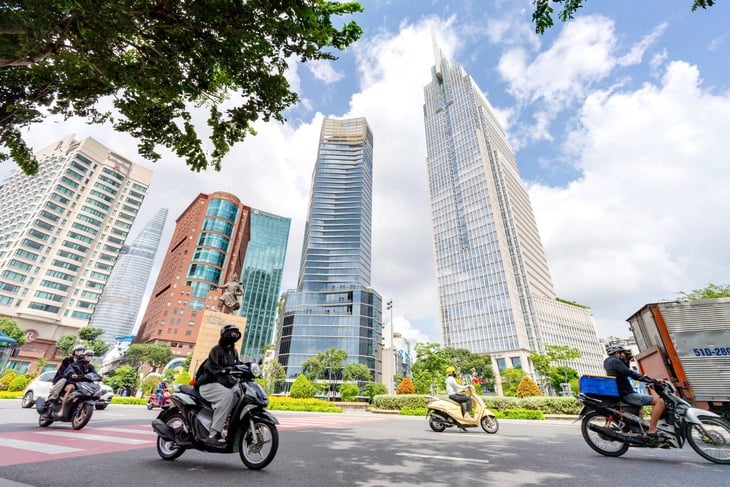
Ho Chi Minh City in the future will be the economic and financial center of the whole country - Photo: VAN TRUNG
Attracting leading financial corporations
Associate Professor Dr. Tran Hoang Ngan said that Vietnam has a great opportunity to develop an international financial center, realizing the dream of becoming a high-speed developing economy.
According to Mr. Ngan, the international financial center must play a role in serving economic development orientation, supporting capital for the economy, businesses and the Government to implement large investment projects such as urban railways and high-speed railways.
Mr. Ngan believes that the international financial center will support the development pillars of Ho Chi Minh City after the merger such as industry, logistics, seaports, high-quality services...
According to him, it is necessary to attract large financial corporations to be present in the financial center to create spillover from their operations and global capital circulation. The lesson is to attract large corporations and financial institutions because they will attract their friends and partners to operate and invest.
In addition, Mr. Ngan also said that it is necessary to invest heavily in transport infrastructure, digital infrastructure, data infrastructure, energy infrastructure, especially digital infrastructure, to connect with global financial centers.
Mr. Mohammad Yousuf Al Najjar - Senior Vice President in charge of development and projects of Dubai International Financial Centre - said that infrastructure is very important for a financial centre, so Vietnam needs to pay attention to these factors when developing the centre.
For the inside of the buildings, there must be a suitable design to meet the large demands of the data centers, so it is necessary to ensure the stability of electricity and cooling systems of the data centers. As for the outside infrastructure, the transportation system must be convenient for experts to get to the offices, including personal vehicles and public transportation such as metro.
In particular, he stressed that one of the most important factors is to have convenient connections to the airport because there are many people coming and going every day at the international financial center.
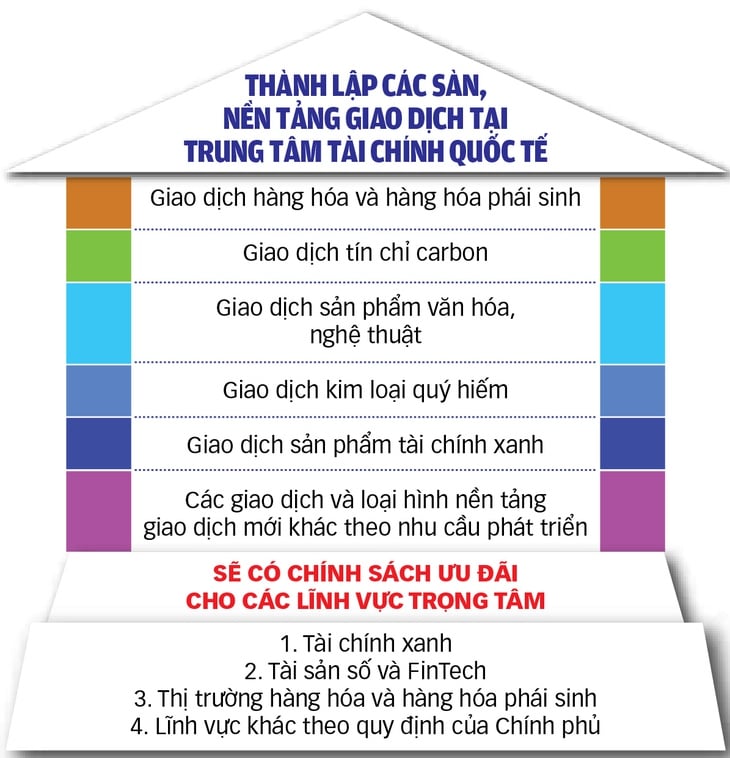
Graphics: TUAN ANH
Need high quality human resources
Associate Professor Dr. Hoang Cong Gia Khanh, Principal of the University of Economics and Law, said that the current trend of financial centers around the world is to focus on establishing a foundation to attract capital, technology and human resources, instead of just capital as before.
Meanwhile, capital, technology and human resources are increasingly cross-border, so the nature of a financial center must be open and very flexible. In addition, Mr. Khanh said that financial centers also prioritize attracting start-ups and small and medium-sized enterprises with financial innovation, so this is something to note.
Meanwhile, Dr. Truong Minh Huy Vu - Director of the Ho Chi Minh City Institute for Development Studies - said that besides infrastructure, Ho Chi Minh City needs to prepare human resources for key areas such as finance, banking, blockchain, artificial intelligence and risk management.
According to Mr. Vu, high-quality human resources will provide professional, efficient financial services that meet international standards, thereby enhancing the reputation and attractiveness of the financial center.
Where is the international financial center located?
The area for building an international financial center in Ho Chi Minh City, as proposed by the Ministry of Finance, is the area of District 1 (old) and Thu Thiem with a planning area of about 686 hectares. In particular, the Thu Thiem area will apply a special mechanism to speed up the progress of urban railway lines and key connecting infrastructure such as pedestrian bridges, river buses, ports, etc.
In Da Nang, the Ministry of Finance proposed to complete investment and put into operation the ICT building at Software Park No. 2 (phase 1) to organize the operation of the international financial center in the fourth quarter of 2025.
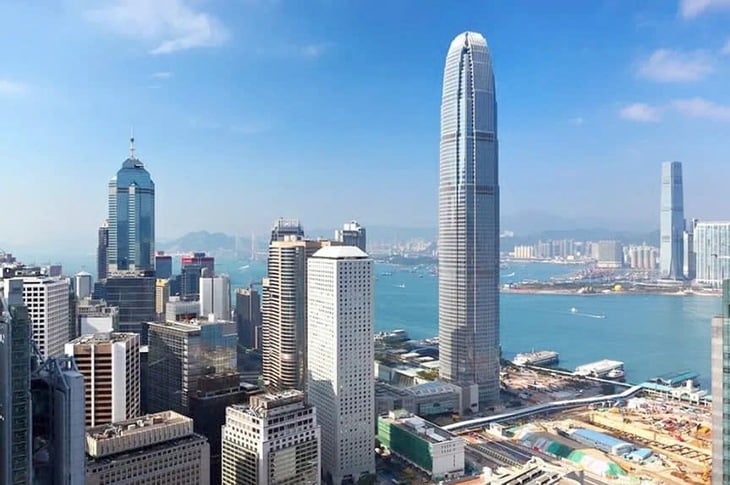
Skyscrapers overlooking Victoria Harbour in Hong Kong's central financial district - Photo: MA Financial Group
The world's leading financial centers
According to the Global Financial Centres Index (GFCI) ranking published in March 2025, the world's top four financial centres today include New York, London, Hong Kong and Singapore.
New York continues to hold the number one spot thanks to its comprehensive and dynamic financial ecosystem. Home to the New York Stock Exchange (NYSE) and Nasdaq - the world's two largest stock exchanges by capitalization, the city is considered a global capital mobilization center.
According to Investopedia, the NYSE has a market capitalization of more than $28 trillion (2024), while Nasdaq stands out with technology giants such as Apple, Microsoft and Google, playing a key role in the development of financial technology (fintech), digital currency and venture capital.
Not only leading the stock market, New York is also the "headquarters" of major investment banks such as JPMorgan Chase, Goldman Sachs and Morgan Stanley along with many of the world's leading asset management and insurance companies.
London ranks second in the rankings, remaining one of the leading financial centers, despite the post-Brexit turmoil. With a stable legal foundation, transparent business environment and diverse financial system, London plays a leading role in many fields, especially the foreign exchange market, accounting for nearly 43% of global foreign exchange transactions every day, equivalent to about 6,600 billion USD (2024).
The London Stock Exchange (LSE) is home to thousands of multinational companies, making it an ideal destination for listing and derivatives trading. In addition, London is promoting green finance, attracting capital flows from ESG (environmental, social and governance) investment funds, contributing to shaping global sustainable finance trends.
Hong Kong is a leading financial centre in Asia. With over 2,500 listed companies and a total market capitalisation of over US$42 trillion (2021), Hong Kong has one of the deepest and most diverse capital markets in the region. Hong Kong is also the world’s third largest US dollar trading centre and plays a strategic role in offshore renminbi transactions.
Green finance has also seen remarkable growth in Hong Kong in recent years. In 2021, Hong Kong saw the issuance of approximately US$31.3 billion in international green bonds, accounting for one-third of the total in the Asian market. Hong Kong continues to attract multinational corporations and international investors, especially in the fintech and blockchain sectors.
Singapore as a financial centre has an advantage over Hong Kong in terms of foreign exchange as it serves the ASEAN region with multiple currencies.
Under its first prime minister Lee Kuan Yew, Singapore, with its strategic position on the world map, gradually transformed itself from a shipping hub to a global financial center.
In the 1980s, Singapore shifted its focus to finance, opening up the financial sector with lighter regulations. The Express Tribune reports that this foundational strategy has paid off, with 4,200 multinational companies now headquartered in Singapore.
Source: https://tuoitre.vn/tp-hcm-diem-den-moi-cua-gioi-tai-chinh-toan-cau-20250802080451164.htm






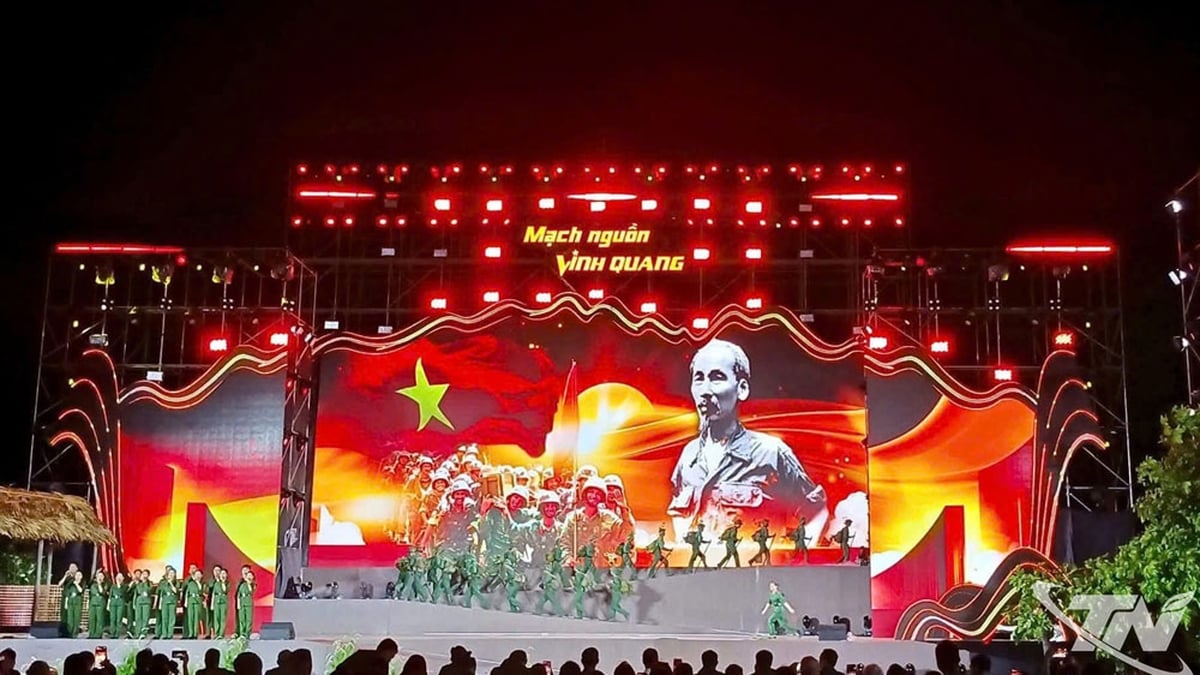




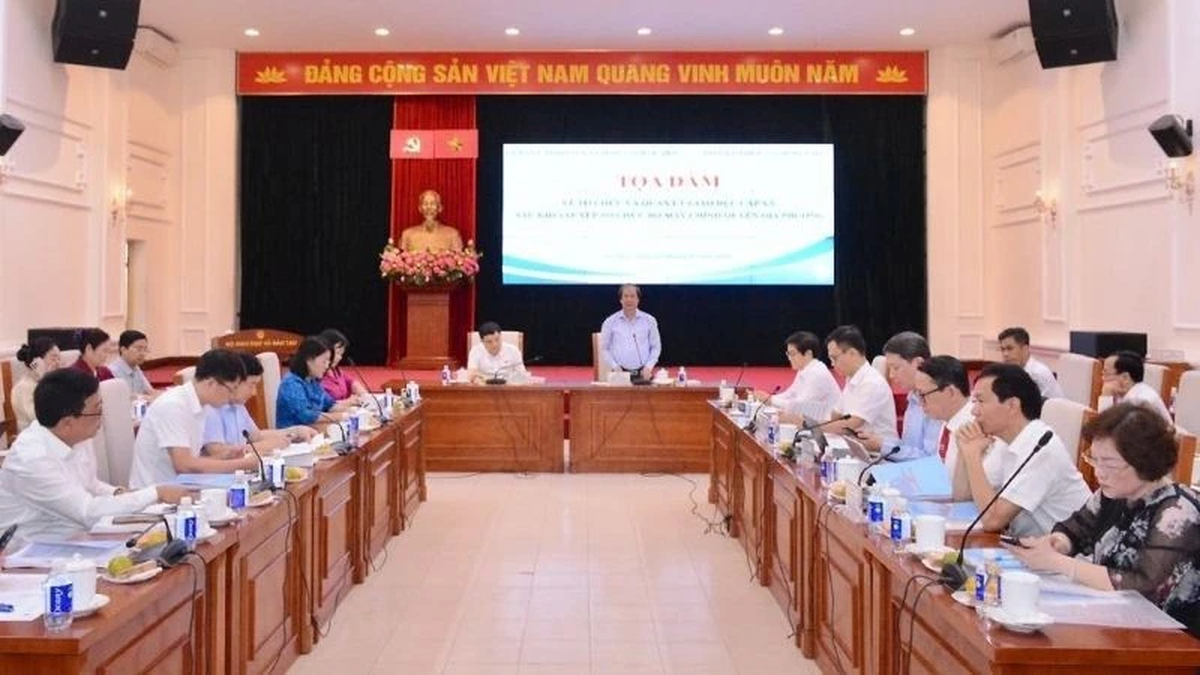






















































































Comment (0)